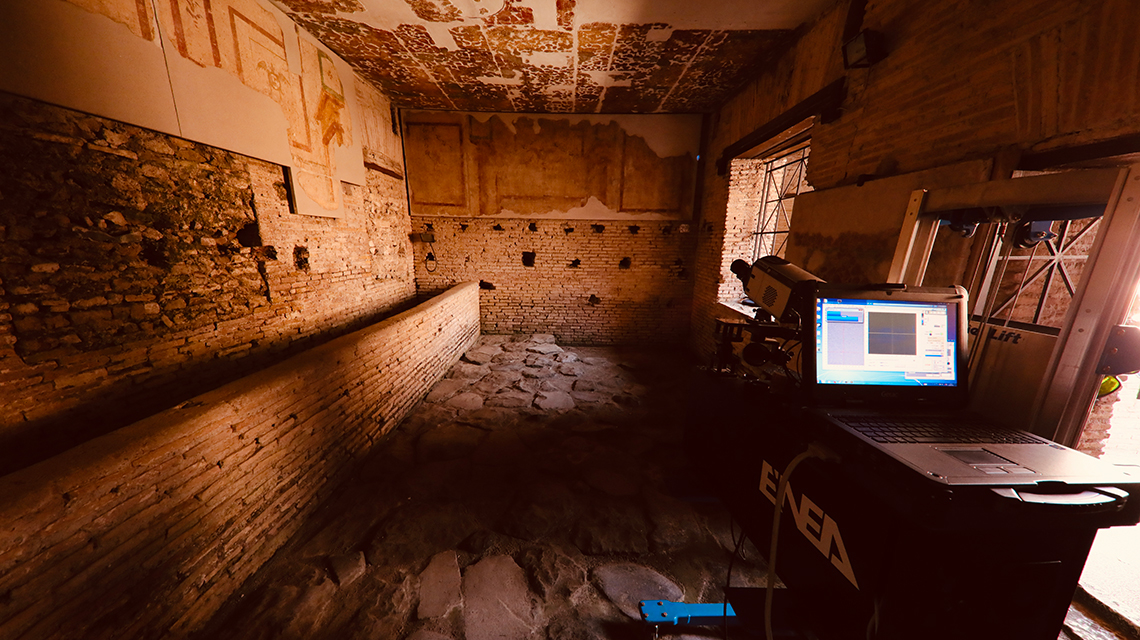Italian National Agency for New Technologies, Energy and Sustainable Economic Development

Innovation: An app to interact with inaccessible cultural heritage
An innovative 3D virtual method for interacting with inaccessible cultural heritage- allowing to capture details not visible to the naked eye- based on a combination of 5G technologies, the cloud, satellite services, photogrammetry and multimedia information, is the outcome of the project VADUS[1], conducted by ENEA, Sapienza University of Rome, the Colosseum and Ostia Antica Archaeological Parks, the Pietro Micca and the 1706 Siege of Turin Museum, TIM, Next-Systems Engineering (coordinator) and funded by the European Space Agency (ESA)[2], presented on 9 and 10 May at the ENEA Frascati Research Center at the Workshop “Research, Development and Applications to the Cultural Heritage. Project VADUS, from outcomes to future collaborations”. As part of the project, virtual visits were organized to Diana's House in Ostia Antica, the Aula Isiaca in the Colosseum Park and the "Pastiss" underground fort in the Pietro Micca Museum in Turin.
During the event -attended by experts, researchers and representatives of superintendencies, cultural institutions, museums and SMEs- virtual visits to the House of Diana and the fort hypogeum "Pastiss" were offered via an app specifically created by Next-Ingegneria dei Sistemi and available on a 5G tablet. The ENEA Diagnostics and Metrology Laboratory provided the virtual visit of the fort Pastiss (closed to public) with the outcomes of the analyses on the paintings of the Pietro Micca Museum, which revealed details invisible to the naked eye or disappeared, like coats of arms or signatures. A virtual tour of Diana's House in the Ostia Antica Archaeological Park- also closed to public - was available, in which the multimedia levels created by ENEA provided information on the construction and restoration of the building. For the Aula Isiaca in the Colosseum Park it was also possible to virtually "reposition" in the original area a fresco decoration preserved elsewhere.
“VADUS, which means 'passage', offers a fully immersive high definition experience, without any spatial or temporal constraints in the itineraries, declined through multilevel storytelling, with archaeological, historical and scientific multimedia contents, supported by reconstructions or virtual recreations”, pointed out Valeria Spizzichino, ENEA researcher at the Diagnostics and Metrology Laboratory. “VADUS – she said –will act as a technological enabler, to overcome the difficulties related to access for environmental reasons, like the preservation of the asset, due to architectural barriers or related to the 'fruition' of a cultural asset”.
ENEA contributed to the project with its innovative prototypes which, using monochromatic laser sources, can work a few tens of meters away: the RGB-ITR radar (Red Green Blue Imaging Topological Radar), which provides for each segment of the surface analyzed three types of information on color and two on distance with submillimeter accuracy, for high-resolution 3D reconstructions in color and without the need for photographic images; the LIF (Laser Induced Fluorescence) Imaging system which allows to analyse the composition of surfaces, creating maps of the distribution of materials and therefore of properties not visible to the naked eye; the IR-ITR (Infra Red Imaging Topological Radar) which allows to retrieve details disappeared due to degradation or covered by successive layers of paint.
The Frascati event was an opportunity for ENEA to present their offer to museums, companies and public administrations in the field of diagnostics, conservation and enhancement of the cultural and landscape heritage and the promotion of the territory. In fact, ENEA has technical-scientific skills in the field of safety, restoration, protection, conservation, monitoring and control - even remotely - of cultural, landscape, archival and book heritage, as well as infrastructures like the shaking tables at the Casaccia Research Center (Rome), which simulate earthquakes in tests for seismic protection. Furthermore, it develops technological tools to preserve and protect works of art, advanced solutions for reducing the vulnerability of the territory and protection from natural events, hi-tech prototypes, nano and biotechnologies, advanced sensors, microorganisms and bio-based products.
Photos and videos
Other archival videos, freely reproducible, are available upon request
